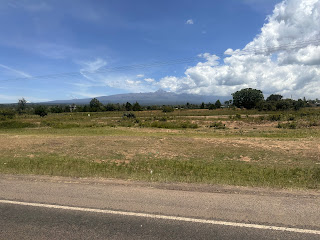Early on Thursday morning we departed for our climb to Mount Kenya. After a frantic morning filled with last minute packing, we ascended the hill above Kijabe, and joined the highway. Our journey took us north over the densely forested woodlands and tightly rolling hills of the Aberdare mountains. We passed by tiny farming villages and fragrant tea plantations blanketing the hills with shimmering green leaves under blue skies. We then left the hill country and descended to the endless plain of the central highlands of Kenya. After passing through what felt like countless fields and villages, we finally saw it: the densely clouded peak of Mount Kenya. This 3 million year old, 17,000 foot extinct stratovolcano is the second tallest peak in Africa, and is also the origin of the name of "Kenya" the country. The Kikuyu people (Kenya's largest ethnic group) Believe that God, or Ngai/Mwene Nyaga lived on mount Kenya (Kirinyaga in the Kikuyu language) when he came down from the sky, and the mountain is Ngai's throne on Earth. With this in mind, I resolved to approach the mountain with a sense of reverence, knowing that it is a sacred place to millions of people throughout the country. In addition to the cultural significance of Matt Kenya, it is also a unique place biologically, with a unique climate, and distinct vegetation bands found at different elevations in the mountain. I was brimming with excitement to see them all!
 |
| Fragrant tea plantations |
 |
| First glimpse of the mountain |
In Nanyuki we met our guide Sam, the assistant guide Alfred, and the rest of the porters/chefs. After one last stop for groceries, we proceeded to the park gate. After some time mulling at the Sirimon gate, making sure our paperwork was in order, and that everything was packed correctly. We proceeded up the mountain to the first night's campsite: Camp Moses. Since it was late in the day, we had to drive halfway to the campsite, and then hike the rest of the way. This was so that we could begin to become accustomed to the increased elevation that we would be encountering the next couple days.
The noise of the road and the city faded away, and we began to feel the tranquility of the mountain enveloping us. We were surrounded by rosewood and cedar forest filled with the song of birds and the rustling of the afternoon breeze. Our main guide, Sam, was a consummate professional, and insisted that we take the route at our own pace, relax, and enjoy ourselves; just what you want to hear from a mountain guide. As we ascended, slowly, the vegetation turn to chaparral, to my surprise. As I looked up, the way to the mountain peak was decorated by bare hillsides populated by scrubby shrubs and sage-like bushes. If I squinted, it felt like I was back in California in the Santa Monica Mountains or up in the bay area.
 |
| Climbing through the low forest zone |
 |
| Looking up the mountain |
After a hike of maybe an hour or two, we reached Camp Moses. It was already after nightfall and the camp was alive with the activity of campers in their tents or in the main hut, and chefs outside preparing the grub. The inside of the hut consisted of a bathroom area with showers and sinks (running water!), two sleeping areas with about 20 bunk beds apiece, and a hall with long tables for mealtimes. The hut echoed with the sounds of trekkers enjoying their hearty meals of soups, starches, and vegetables. Most had come from Europe and North America, and I could hear Russian and French being spoken at a couple of the tables. We ate a simple dinner of potatoes and curried vegetables and then retired to prepare for the long journey ahead. Meanwhile Sam insisted in his signature serious but caring tone that everyone drink plenty of water: "It is the mountain's remedy", he insisted. I happily complied, eager to stave off any unpleasant altitude or trekking related symptoms. I managed, though, to sneak out for a moment to watch the stars and encountered a couple southern features that were new to me: Eridanus, the river constellation, which contains the star Achernar (which just sounds really cool), and Canopus, the sky's second brightest star (only visible from below 37 degrees north, which excludes Canada and most of Europe and the United States). After that I dashed off to bed to dream of river gods, giant groundsels, and thunderous mountain peaks.
 |
| First night: Camp Moses |
 |
| A view inside the hut |
 |
| Stargazing: a view of Orion, Sirius and Procyon (the new iPhone's camera allowed me to indulge in some amateur nighttime photography!) |







No comments:
Post a Comment